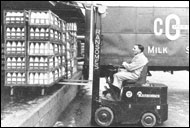 On February 1st 1958 BT Industries in Sweden commissioned a new extension to their Mjolby factory. This event was celebrated by the production of three new products. The first was an electric, rider seated, support arm stacker called the RSS 10, which had fixed forks and a duplex mast. The other two were essentially production machine aids, and were called the LG lifting fork and the VB lifting table. Jungheinrich of Germany also benefited from an extension to their production capacity with a new factory in Hamburg Wandsbek. In addition, they launched a new truck model. This was the Ameise 65 DFG 15 G, the company’s first diesel powered forklift truck.
On February 1st 1958 BT Industries in Sweden commissioned a new extension to their Mjolby factory. This event was celebrated by the production of three new products. The first was an electric, rider seated, support arm stacker called the RSS 10, which had fixed forks and a duplex mast. The other two were essentially production machine aids, and were called the LG lifting fork and the VB lifting table. Jungheinrich of Germany also benefited from an extension to their production capacity with a new factory in Hamburg Wandsbek. In addition, they launched a new truck model. This was the Ameise 65 DFG 15 G, the company’s first diesel powered forklift truck.
In Britain after many successful years manufacturing conveyor systems, hand operated stackers and stillage trucks J.Collis & Sons Ltd launched a new truck onto the market. The Type ‘B P’ hand pallet truck had 22 inch wide x 48 inch long forks and a 1 ton lifting capacity. The spring balanced steering arm was used for operating the hydraulic hand lift pump and also for hauling the load. This arm returned to the upright position when released.
On the powered front Omic launched a new pedestrian controlled, electric pallet truck at the MHE show in May. The model ‘EP 40’, known as the ‘Paliton’, had a lifting capacity of 2 tons and was available in 20in and 27inch fork widths, with three standard lengths of 36in, 42in and 48in. A twist grip control gave three speeds in forward and reverse. The brakes were of the automatic disc type with a ‘dead man’ control, operated through a safety microswitch in the control head.
At the same show, Ransomes Sims and Jeffries displayed their new range of electric counterbalance trucks. In their sales information the company stated that the `NR` series of trucks were the first to be produced in Britain using the latest in British and American research. This, they said, “permitted the design of a forklift truck with minimum dimensions.” The joint findings, based on new stability tests, were closely related to actual working conditions. This meant that by following the information gained from these tests it was possible that an overall standard truck formula could be obtained, with implications for savings in reduced aisle widths and consequential storage space.
An important part of the test apparatus was a floor-mounted platform, capable of supporting a forklift truck and being tilted hydraulically. This facility was installed in RSJ’s works as part of the new truck building programme, and enabled the company to examine all their machines for both longitudinal and lateral stability. Today this type of test is employed in most forklift truck design.
Among the other major exhibits at the May Show were two side-operating carriers made by the Irion Company and exhibited by Materials Handling Equipment (GB) Ltd. One was the tried and tested 3-ton capacity ‘Kestrel’, the other the 5-ton capacity ‘Falcon’. Originally both machines were fitted with a Mercedes Benz diesel engine, but from this date the ‘Kestrel’ engine was replaced by a diesel engine and transmission unit from Ford. The specification change was made to meet MHE’s claim that the ‘Kestrel’ was now made in the UK entirely from British components.
To be continued
By James Brindley, Director, National Fork Truck Heritage Centre





1 Comment
need imformation on longitudinal. lateral ,centre of gravity